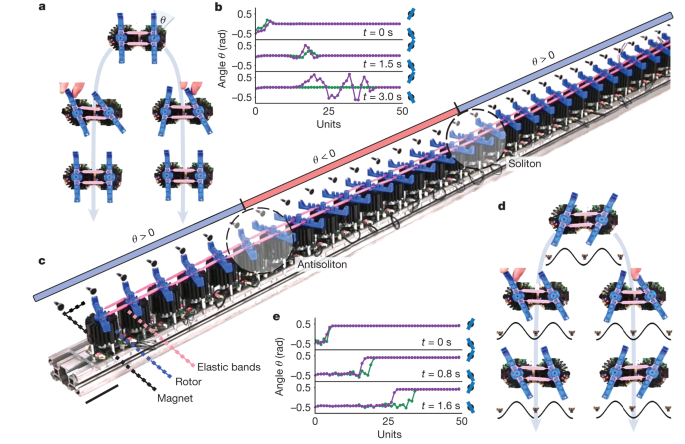Non-Reciprocal Topological Solitons in Active Metamaterials
แนวคิดหลัก
Non-reciprocal driving mechanism creates robust topological solitons in active metamaterials.
บทคัดย่อ
The content discusses the introduction of a local driving mechanism for solitons that accelerates both solitons and antisolitons in the same direction through non-reciprocal driving. It explores the construction of an active mechanical metamaterial to achieve this, leading to the formation of non-reciprocal topological solitons known as non-Hermitian skin waves. These solitons are utilized in constructing an active waveguide for transmitting and filtering unidirectional information. The study also touches on the breaking of 'supersymmetry' in another class of metamaterials, causing only antisolitons to be driven. The interplay between non-reciprocity and topological solitons is highlighted, showcasing how solitons generate their driving force by locally straining the material. The implications extend beyond the study, suggesting potential applications in robotic locomotion, quantum mechanics, optics, and soft matter.
Non-reciprocal topological solitons in active metamaterials - Nature
สถิติ
"existing driving mechanisms all accelerate solitons and antisolitons in opposite directions"
"construct an active mechanical metamaterial consisting of non-reciprocally coupled oscillators"
"nonlinearity coaxes non-reciprocal excitations—so-called non-Hermitian skin waves—into robust one-way (anti)solitons"
"breaking of ‘supersymmetry’ causing only antisolitons to be driven"
คำพูด
ข้อมูลเชิงลึกที่สำคัญจาก
by Jonas Veenst... ที่ www.nature.com 03-20-2024
https://www.nature.com/articles/s41586-024-07097-6
สอบถามเพิ่มเติม
How can the concept of non-reciprocal solitons be applied practically outside of metamaterials
The concept of non-reciprocal solitons, as demonstrated in active metamaterials, can find practical applications beyond this specific domain. One potential application could be in the field of robotics for efficient locomotion mechanisms. By harnessing the unique properties of non-reciprocal driving, robotic systems could potentially achieve more energy-efficient and stable movement patterns. The unidirectional nature of non-reciprocal solitons could enable robots to navigate complex terrains with greater precision and control. Additionally, these solitons could be utilized in designing advanced communication systems where information transmission needs to be strictly one-way.
What potential challenges or drawbacks could arise from relying on non-reciprocal driving mechanisms for various applications
While non-reciprocal driving mechanisms offer exciting possibilities for various applications, there are potential challenges and drawbacks that need to be considered. One significant challenge is the complexity involved in engineering materials or systems capable of exhibiting non-reciprocal behavior reliably over extended periods. Maintaining the desired directional motion without interference or external disturbances may pose technical difficulties. Moreover, the reliance on such specialized driving mechanisms might limit flexibility and adaptability in certain scenarios where bidirectional control is necessary. Another drawback could be related to scalability and cost-effectiveness when implementing these mechanisms across large-scale systems.
How might the understanding of non-reciprocal topological solitons impact advancements in quantum mechanics or soft matter research
The understanding of non-reciprocal topological solitons has the potential to significantly impact advancements in quantum mechanics and soft matter research areas. In quantum mechanics, where controlling particle behavior at a fundamental level is crucial, the emergence of non-reciprocal solitons could open up new avenues for manipulating quantum states and information processing efficiently. These solitonic structures may play a vital role in developing novel quantum computing architectures or enhancing quantum communication protocols by enabling robust one-way transport of qubits.
In soft matter research, which focuses on understanding complex behaviors exhibited by materials like polymers or colloids, insights from non-reciprocal topological solitons can lead to breakthroughs in designing responsive materials with tailored mechanical properties. By leveraging the principles behind these solitonic excitations, researchers can explore innovative ways to engineer soft matter systems that exhibit controllable directional responses under external stimuli. This deeper understanding may pave the way for creating smart materials with applications ranging from adaptive textiles to biomedical devices.
0
